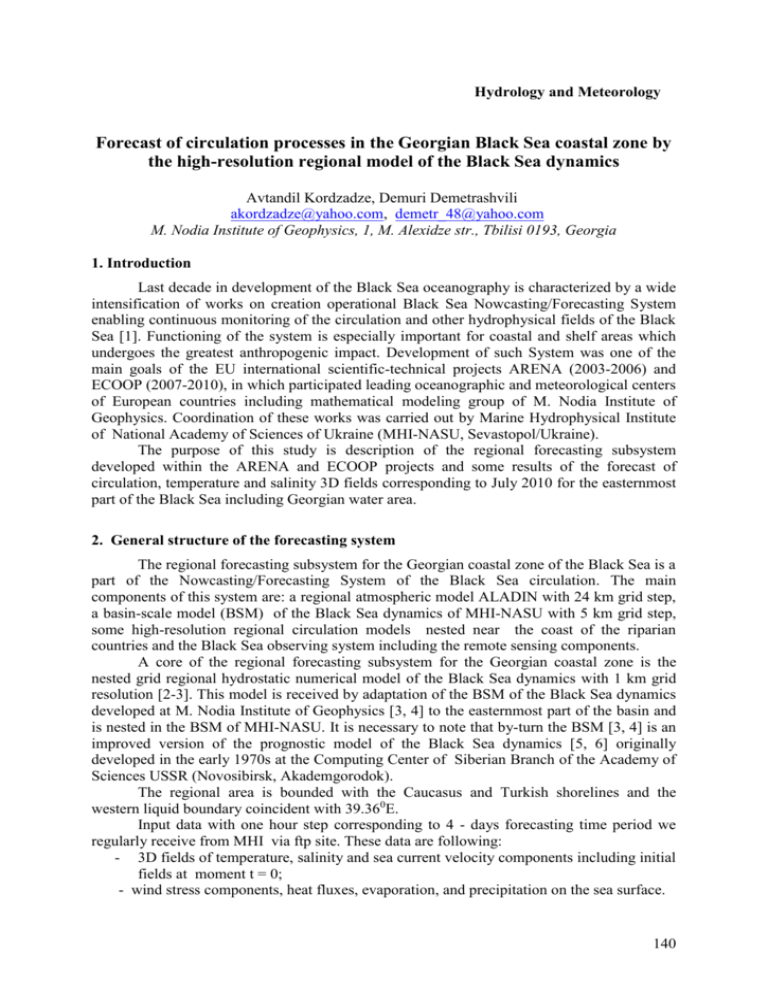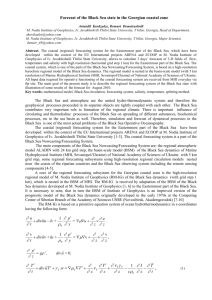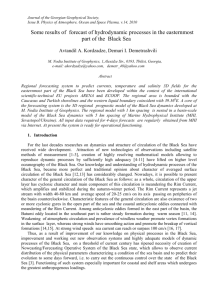Hydrology and Meteorology
advertisement

Hydrology and Meteorology Forecast of circulation processes in the Georgian Black Sea coastal zone by the high-resolution regional model of the Black Sea dynamics Avtandil Kordzadze, Demuri Demetrashvili akordzadze@yahoo.com, demetr_48@yahoo.com M. Nodia Institute of Geophysics, 1, M. Alexidze str., Tbilisi 0193, Georgia 1. Introduction Last decade in development of the Black Sea oceanography is characterized by a wide intensification of works on creation operational Black Sea Nowcasting/Forecasting System enabling continuous monitoring of the circulation and other hydrophysical fields of the Black Sea [1]. Functioning of the system is especially important for coastal and shelf areas which undergoes the greatest anthropogenic impact. Development of such System was one of the main goals of the EU international scientific-technical projects ARENA (2003-2006) and ECOOP (2007-2010), in which participated leading oceanographic and meteorological centers of European countries including mathematical modeling group of M. Nodia Institute of Geophysics. Coordination of these works was carried out by Marine Hydrophysical Institute of National Academy of Sciences of Ukraine (MHI-NASU, Sevastopol/Ukraine). The purpose of this study is description of the regional forecasting subsystem developed within the ARENA and ECOOP projects and some results of the forecast of circulation, temperature and salinity 3D fields corresponding to July 2010 for the easternmost part of the Black Sea including Georgian water area. 2. General structure of the forecasting system The regional forecasting subsystem for the Georgian coastal zone of the Black Sea is a part of the Nowcasting/Forecasting System of the Black Sea circulation. The main components of this system are: a regional atmospheric model ALADIN with 24 km grid step, a basin-scale model (BSM) of the Black Sea dynamics of MHI-NASU with 5 km grid step, some high-resolution regional circulation models nested near the coast of the riparian countries and the Black Sea observing system including the remote sensing components. A core of the regional forecasting subsystem for the Georgian coastal zone is the nested grid regional hydrostatic numerical model of the Black Sea dynamics with 1 km grid resolution [2-3]. This model is received by adaptation of the BSM of the Black Sea dynamics developed at M. Nodia Institute of Geophysics [3, 4] to the easternmost part of the basin and is nested in the BSM of MHI-NASU. It is necessary to note that by-turn the BSM [3, 4] is an improved version of the prognostic model of the Black Sea dynamics [5, 6] originally developed in the early 1970s at the Computing Center of Siberian Branch of the Academy of Sciences USSR (Novosibirsk, Akademgorodok). The regional area is bounded with the Caucasus and Turkish shorelines and the western liquid boundary coincident with 39.360E. Input data with one hour step corresponding to 4 - days forecasting time period we regularly receive from MHI via ftp site. These data are following: - 3D fields of temperature, salinity and sea current velocity components including initial fields at moment t = 0; - wind stress components, heat fluxes, evaporation, and precipitation on the sea surface. 140 Received from MHI data corresponds to our regional area and are given on the grid of the BSM of MHI with grid step approximately 5 km. Data on the sea surface are prognostic fields calculated on the basis of the model of the atmospheric dynamics ALADIN; 3D fields of temperature, salinity and velocity components are prognostic fields calculated with use of the BSM of MHI. 3. Model description The regional model (RM) is based on a primitive equation system of ocean hydrothermodynamics in z-coordinates having the following form: u 1 p u div uu lv + = u , z z t 0 x v 1 p v div uv + lu + = v , t 0 y z z p g , z div u = 0, T T T T 1 I T div uT T .w T T T , t z z z c z t (1) S S S S S div uS + S w = S S S , t z z z t = T T + S S , T T , z S S , z T T ( z, t ) T , S S ( z, t ) S , = ( z, t ) , p p( z, t ) p , = , x x y y I 0 a sinh 0 b sinh 0 , I R0 e z , R 0 = (1 A ) I 0 , sinh 0 sin sin cos cos cos T f / T 10 3 (0.0035 0.00938T 0.0025 S ), 12 ~ t , 1 (a~ b n~)n~ . S f / s 10 3.(0.802 0.002T ) . Here u, v, and w are the components of the current velocity vector u along the axes x, y, and z, respectively (the axes x, y, and z are directed eastward, northward and vertically downward from the sea surface, respectively); T , S , P , are the deviations of temperature, salinity, pressure and density from their standard vertical distributions T , S , P , ; l l 0 . y is the Coriolis parameter, where dl / dy ; g , c and 0 are the gravitational acceleration, the specific heat capacity and average density of seawater; , T ,S , , T ,S are the horizontal and vertical eddy viscosity, heat and salt diffusion coefficients, respectively; I 0 is the total solar radiation flux at z 0 determined by the Albrecht formula, A is the albedo of the sea surface, 141 h0 is the zenithal angle of the Sun; is the geographical latitude, is the parameter of declination of the Sun, is the factor which takes into account influence of cloudiness on ~ total radiation and depends upon ball of cloudiness n~ ; a, b, a~, b are the empirical factors; is the parameter of absorption of short-wave radiation by seawater. System of equation (1) is subject to the following boundary and initial conditions: z y v , z 0 u zx , z 0 T = T * T(0, t ) or T S = S* S(0, t ) or T QT R 0 z S if z = 0, S (PR EV )S0 , z u 0 , v = 0 , w = 0, T / z T , S/ z S on z H ( x , y) , u 0, v = 0, T / n 0 , S/ n 0 on ~ ~ u~ u , v= ~ v , T = T , S = S on u u 0 , v = v 0 , T = T 0 , S = S 0 if t = 0, (2) Г0 , Г1 , (3) where H describes the relief of the basin bottom; zx , zy , T , S are the wind stress * * components along the axes x and y, temperature and salinity at the sea surface (z = 0), respectively; Q T QT / c , where QT is the turbulent heat flux in the atmosphere; R 0 R 0 / c ; Г0 is the lateral surface adjacent to the land, and Г1 is the liquid boundary ~ ~ u , ~ v , T , S are the separating the regional water area from the open part of the Black Sea. ~ current velocity components along the axes x and y and the deviations of temperature and velocity at the liquid boundary, respectively (they are prognostic values predicted by the BSM of MHI-NASU). PR and EV are the atmospheric precipitation and evaporation. The coefficients of horizontal turbulent viscosity and vertical turbulent diffusion for heat and salt were calculated in the process of integration of the model equations by formulas given in [4]. The existence and uniqueness theorem proving of 3D nonstationary problem of sea dynamics are given in [7]. For solving the problem (1)-(3) we used the two-cycle method of splitting the main problem with respect to both physical processes and coordinate planes and lines [8]. 4. Key model parameters The domain of solution was covered with a grid 193 x 347 having horizontal resolution 1 km. On a vertical the non-uniform grid with 30 calculated levels on depths: 1, 3, 5, 7, 11, 142 15, 25, 35, 55, 85, 135, 205, 305, …, 2005 m were considered. The time step was equal to 0.5 h. The parameter of radiation absorption was accepted as equal to 0.0023m 1 , which corresponds to usual ocean water, where about 10% of radiation reaches depth of 10 m [4]. ~ Empirical factors accepted values: 1.54kW / m 2 , b 0.22kW / m 2 , ~ a b 0.38 . Specific heat capacity c 4.09Jg 1K 1 , which corresponds to a seawater with salinity 18%. The other parameters had the following values: g = 980 cm2/s, 0 1g / cm 3 , l 0 0.95 10 4 s 1 , 10 13 cm 1s 1 , 5. Results of forecast, July 2010 At present, we regularly calculate 4-days forecasts of current, temperature, and salinity fields for the above mentioned regional area by the RM with use of initial and boundary fields obtained from MHI-NASU via ftp site. (a) (b) (c) (d) Fig.1. The current field at initial time of forecast on depths of (а) 0 m, (b) 200 m, (c) 500 m, (d) 1000 m. 143 To demonstrate calculations of forecast by the RM we chose the forecasting period: 18 July 2010, 00:00 h – 22 July 2010, 00:00 h. Atmospheric circulation during 18 – 21 July 2010 was characterized by significant variability above the easternmost part of the Black Sea. Fig.1 illustrates the Black Sea circulation at initial time of forecast on different horizons. From this figure it is clear that the main element of regional circulation is Batumi anticyclonic eddy, which covers the area with diameter about 100-120 km. This vortex practically does not change in the upper 200 m layer, only current speed decreases from maximal value equal to 34 cm/s till 12 cm/s. Below 200 m the vortex gradually decreases in sizes (see, Fig. 1c) and on the depth of 1000 m it is not observed any more (see, Fig. 1d). (a) t = 48 h (b) t = 96 h Fig.2. The surface current fields at (a) 48 h and (b) 96 h (here and in following Figures time is counted from initial moment of the forecast) predicted by the RM. . Figs. 2-4 illustrate current, temperature and salinity fields predicted by the RM at the time moments 48 and 96 h after beginning of integration (18.07.2010, 00:00 h). Circulation patterns are shown on z = 0, but temperature and salinity fields – on z = 20 m. From Fig.2 it is obvious that Batumi anticyclonic eddy insignificantly depends on changeability of atmospheric wind forcing and is rather stable formation, it is observed during all forecasting period without strong changes. Batumi eddy most of all is exposed to some changes on the fourth day of the forecast and its centre is displaced a little on the southwest side (Fig.2b). Here the narrow zone with width about 10-15 km along seashore is obviously allocated, where movement of waters sharply differs from other part of the regional area and currents have tendency to vortex formation of very small sizes. From Figs. 3 and 4 are shown that prognostic temperature and salinity fields are changing a little during the forecasting period, but main features of distribution of these fields remain the same. 144 (a) t = 48 h (b) t = 96 h Fig.3. The temperature fields on depth of 20 m at (a) 48 h and (b) 96 h predicted by the RM. (a) t = 48 h (b) t = 96 h Fig. 4. The salinity fields on depth of 20 m at (a) 48 h and (b) 96 h predicted by the RM. Figs. 5-7 illustrate prognostic fields of current, temperature, and salinity computed by the BSM of MHI-NASU. The patterns are on the same horizons and at the same time moments as in Figs. 2-4. Comparison of Figs. 5 and 2 shows that circulation patterns predicted by the RM and the BSM are similar (configuration, sizes, intensification), Batumi anticyclonic eddy covers the significant part of the regional area. It should be noted that according to the results [4, 9], Batumi eddy is the main element of a regional circulation in this part of the basin for the summer season. The most considerable distinctions are observed in a narrow zone along the coastline. The basic distinctions between temperature fields predicted by the RM and the 145 BSM is that in a zone of development Batumi eddy values of temperature predicted by the RM are higher than values of temperature predicted by the BSM (see, Figs 6 and 3). (a) t = 48 h (b) t = 96 h Fig.5. The surface current fields at (a) 48 h and (b) 96 h predicted by the BSM of MHINASU (a) t = 48 h (b) t = 96 h Fig.6. The temperature fields on depth of 20 m at (a) 48 h, of MHI-NASU. (b) 96 h. predicted by the BSM Concerning salinity fields, there is more similarity between fields predicted by both RM and BSM. Particularly, in both cases the zones of lower salinity are in the central area of Batumi anticyclonic eddy. It is easy to explain this fact by that descending streams which develop in the anticyclonic vortex, transfer less salty waters from the upper layer downwards. 146 (a) t = 48 h (b) t = 96 h Fig.7. The salinity fields on depth of 20m at (a) 48 h, (b) 96 h predicted by the BSM of MHI . 6. Conclusion A regional forecasting system allowed to predict flow, temperature and salinity fields with 1 km spacing in the easternmost part of the Black Sea is developed. A core of the forecasting system is the hydrostatic baroclinic regional model of the Black Sea dynamics, which is nested in the BSM of MHI. Main features of regional circulation for July 2010 predicted both by the RM and the BSM of MHI are practically the same, but more differences are observed in the narrow zone along sea shoreline. In this near-shore zone the flow predicted by the RM is characterized by more tendency to form eddies of small sizes. Some differences are also observed in temperature and salinity fields predicted by both models. Finally, it should be noted that at present to verify results of the forecast by comparison with the real data is not possible because of the absence of the observational data. However, such comparisons have been done during pilot experiment within the project ARENA in 2005, which showed an ability of the regional model to predict hydrophysical fields with sufficient accuracy [10]. References 1. Korotaev G. K., Eremeev V. N. Introduction to the Operative Oceanography of the Black Sea. Sevastopol/Ukraine, NPC “EKOCI-Gidrofizika”, 2006, 382p (in Russian). 2. Kordzadze A., Demetrashvili D. Simulation and forecast of hydrophysical fields in the part of the Georgian Black Sea coastal zone. J. Georgian Geophys. Soc., vol. 12b, Tbilisi, 2008, pp. 3-16. 3. Kordzadze A., Demetrashvili D. Modeling of dynamical processes in the Black Sea. Georgian Elecreonic Scientific Journal (GESJ): Physics. N 1(3), 2010, http://gesj.internet- academy.org.ge/phys/ , pp. 25-45. 4. Kordzadze A. A., Demetrashvili D. I., Surmava A. A. Numerical modeling of hydrophysical fields of the Black Sea under the conditions of alternation of atmospheric circulation processes. Izv. RAN, Fizika Atmosfery i Okeana, t. 44,. 147 N 2, Moscow, 2008, pp. 227-238 (in Russian). 5. Marchuk G. I., Kordzadze A. A., Skiba Yu. N. Calculation of major hydrological fields of the Black Sea on the basis of the splitting method. Izv. Akad. Nauk SSSR, Fizika atmosferi i okeana, t. 11, Moscow, 1975, pp. 379-393 (in Russian). 6. Kordzadze A. A. Mathematical modelling of sea currents (theory, algorithms, numerical experiments). Moscow, OVM AN SSSR, 1989, 218 p (in Russian). 7. Kordzadze A. A. Mathematical problems of solving problems of ocean dynamics. VTs SO AN SSSR, Novosibirsk (Akademgorodok), 1982, 148 p (in Russian). 8. Marchuk G. I. Numerical solution of problems of atmospheric and oceanic dynamics. Leningrad, Gidrometeoizdat, 1974, 303 p (in Russian). 9. Korotaev G., Oguz T., Nikiforov A., Koblinsky C. Seasonal, interannual, and mesoscale variability of the Black Sea upper layer circulation derived from altimeter data. J. Geophys. Research, vol. 108, No C4, doi: 10.1029/2002JC001508, 2003, pp. 19-1 – 19-15. 10. Kubriakov A., Grigoriev A., Kordzadze A., Korotaev G., Trukhchev D., Fomin V. Nowcasting/Forecasting subsystem of the circulation in the Black Sea nearshore regions. In: European Operational Oceanography: Present and Future. 4th EuroGOOS Conference, 6-9 June 2005, Brest, France,. 2006, pp. 605-610. SUMMARY In this study the regional forecasting system developed within the International scientifictechnical EU projects ARENA and ECOOP and some results of the forecast of circulation, temperature and salinity 3D fields corresponding to July 2010 for the easternmost part of the Black Sea, including Georgian water area, are described. A core of the regional forecasting system is the nested grid regional hydrostatic numerical model of the Black Sea dynamics, which is based on a primitive equation system of ocean hydro-thermodynamics. This regional model is created by adaptation of the basin-scale model (BSM) of the Black Sea dynamics developed at M. Nodia Institute of Geophysics (Tbilisi, Georgia) to the easternmost part of the basin and is nested in the BSM of Marine Hydrophysical Institute (MHI, Sevastopol/Ukraine). The easternmost regional area, which is bounded with the Caucasus and Turkish shorelines and western liquid boundary coincident with 39.360E, was covered with grid 193x347 having horizontal resolution 1 km. On a vertical the non-uniform grid with 30 calculated levels was considered. All Input data with one hour step corresponding to 4 - days forecasting time period we receive regularly from MHI via ftp site. At present, the system is ready for operational functioning. 148







